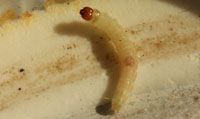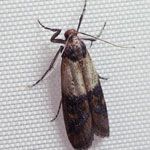What does it look like?
The adult
The adult is a nocturnal butterfly. It measures 10-12mm long. The butterfly has a triangular shape when its wings are together. The tip of the wings is reddish-brown.
The butterfly
 The butterfly is beige with two brownish bands on the wings (when opened). The larvae or caterpillar has a brown head. The body is white, light green or ligth pink. It is 10-15 mm long.
The butterfly is beige with two brownish bands on the wings (when opened). The larvae or caterpillar has a brown head. The body is white, light green or ligth pink. It is 10-15 mm long.
Does the Indian Meal Moth represent a risk for me or my belongings?
The butterfly does not cause any damage since it has no mouth and does not eat. It is the larva that is problematic. The larva eats any type of food; starch, flour, grains, cereals, raw pasta, dried fruits, chocolate, cookies, nuts.
The larva can pierce through plastic bags and some carboard containers. Contaminated food should not be eaten because you can get sick.
Call an expert Ask an expert » Get a quick quote »What are the signs of its presence?
The infestation is often caused by already contaminated food. Indian Meal Moth eggs cannot be detected when you buy food (ex : flour, seeds, nuts, cookies, bulk food, dry pet food). Once the eggs hatch, one may see the caterpillars or notice silk threads in the contaminated bag.
The origin of the infestation can also come from outside. Indian Meal Moth lives outside and is attracted to sunflower seeds, such as bird feeding spots. This moth can fly through screen holes or open patio doors. Another infestation origin is through mice or squirrels.
They carry seeds inside houses. These seeds can contain Indian Meal Moth eggs. These eggs will hatch in between walls, in the attick, wherever the rodents stored the seeds. There could then be several hundreds of butterflies coming out in the house.
Call an expert Ask an expert » Get a quick quote »What should I do if I have the Indian Meal Moth in my house?
First, clean up your pantry. Examine all food bags, containers and throw away all contaminated food. Vacuum the shelves to clean crumbs, flour, sugar, etc.
The exterminator from SOS Bugs will inspect where the infestation source is and what treatment to do. Our biologist will use pheromon traps specific to this butterfly, to catch the adults so they stop reproducing.
A treatment could be done in cracks and crevices in the pantry, if needed. Call a real pest control specialist at 819-328-7017.
Call an expert Ask an expert » Get a quick quote »


